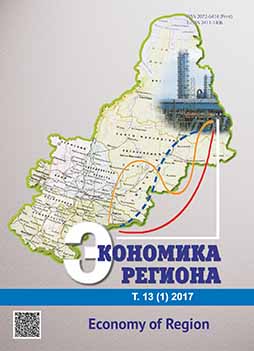Экономика арктических «островов» (на примере Ненецкого и Чукотского автономных округов)
Economy of the Arctic “Islands”: The Case of Nenets and Chukotka Autonomous Okrugs
Author(s): Alexander Nikolayevich Pelyasov, Natalya Vasilyevna Galtseva, Elena Aleksandrovna AtamanovaSubject(s): Economy, Geography, Regional studies
Published by: Институт экономики Уральского отделения Российской академии наук
Keywords: arctic economy; sector of economy; traditional economy; landscape; natural asset; space; sustainable development; structure of okrug; rental model; transfer model of economy;
Summary/Abstract: The article discusses the economy of Arctic «islands». These territories of the Russian Arctic are unavailable by transport all the year round and have considerable specificity in comparison with the other regions of the Russian and North European Arctic. The authors consider the economy of Arctic «islands» on the example of the Nenets and Chukotka Autonomous Areas. Despite the significant similarity in the economic and social parameters, after careful study, two regions show considerable internal differences. In order to identify dissimilarity, in the comparative analysis, we use the theoretical idea of the Arctic economy as a unity of three sectors — the traditional one, corporate (market) one and transfer (state) one. Each sector has the key contradictions, structures and its trajectory of evolution. The comparison of traditional sectors reveals significant landscape diversity of Chukotka in comparison with the Nenets tundra. The corporate sector of the Nenets Autonomous Okrug economy is significantly younger than in Chukotka, due to the fact that oil and gas development is relatively new practice for the region. On the other hand, because of the mining development of Chukotka gold, which started in 1960-s, it can be considered as an old industrial region. The level of the profitability of gold production is significantly lower than of the Nenets oil production. Therefore, we propose to include the economy of the Nenets Autonomous Okrug to the rental model, and Chukotka economy to the transfer model. The difference of transfer sectors of two areas is the result of not only the difference in the power of the regional budgets, but also of the urban settlement structure which is centralized in the Nenets Autonomous Okrug and polycentric in Chukotka. It means that the public health and culture in the Nenets Autonomous Okrug are dated generally for the capital of Naryan-Mar, and social facilities in Chukotka are significantly decentralized and concentrated in Okrug’s and regional centres.
Journal: Экономика региона
- Issue Year: 13/2017
- Issue No: 1
- Page Range: 114-125
- Page Count: 12
- Language: Russian

